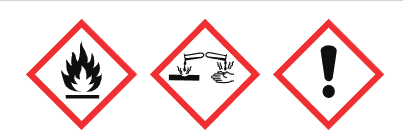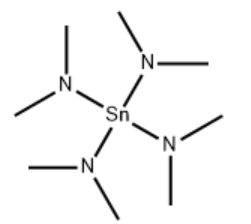TETRAKIS(DIMETHYLAMINO)TIN CAS#: 1066-77-9; ChemWhat Code: 36025
Identification
Physical Data
| Appearance | Colorless to light yellow liquid |
| Boiling Point, °C | Pressure (Boiling Point), Torr |
| 53 – 55 | 0.1 |
| 51 | 0.15 |
| Density, g·cm-3 | Reference Temperature, °C |
| 1.1687 | 20 |
Spectra
| Description (NMR Spectroscopy) | Nucleus (NMR Spectroscopy) | Solvents (NMR Spectroscopy) | Frequency (NMR Spectroscopy), MHz |
| Spectrum | 1H | ||
| Spectrum | 13C | 176 |
Route of Synthesis (ROS)
Route of Synthesis (ROS) of Tetrakis(dimethylamino)tin(IV) CAS 1066-77-9
| Conditions | Yield |
| With 2,2′,2”-triaminotriethylamine In diethyl ether Glovebox; Inert atmosphere; Sealed tube Experimental Procedure t-BuSn(NMe2)3 is prepared by the reaction of t-BuMgCl and Sn(NMe2)4 in diethyl ether; t-BuMgCl (2.0 M) and Sn(NMe2)4 (99.9% trace metals) are produced by Sigma-Aldrich (Sigma-Aldrich) provided. In this reaction, the tertiary butyl group from Grignard reagent replaced a dimethylamino group (-N(CH3)2). The 119 Sn NMR spectrum in Figure 3 shows that the approximate molecular purity of the product t-BuSn(NMe2)3 (δ= -85.6 ppm) is 94% by peak integration; 1% is (t-Bu)2 Sn (NMe2 )2 (δ= -56.2 ppm), and the remaining 5% is Sn(NMe2 )4 (δ= -120.2 ppm).In a glove box filled with Ar (g) and >0.5 ppm O2 (g), put 1202.57 grams of t-BuSn(NMe2)3 into a 2-neck, 2-liter round bottom flask with a 1.25-inch egg-shaped stir bar. 34.3 g (6 mole %) of tris(2-aminoethyl)amine (TREN, Alfa Aesar) was added to the flask and stirred to form a milky white suspension. One neck of the 2-liter flask is equipped with a Teflon valve, and the other neck is sealed with a 24/40 glass stopper. Remove the flask from the glove box and connect to Schlenk tubing. Use the following packed column distillation settings to perform purification:• Hei-Tec stirring plate with Pt/1000 RTD probe and temperature feedback control. • Silicone oil bath.• 300mm vacuum jacketed 24/40 Hempel distillation column (Sigma-Aldrich)• 0.24 inch 316 stainless steel saddle wire mesh column packing (Ace-Glass)•Vacuum jacketed 24/40 short-path distillation head with water-cooled condenser (Chemglass)• 1 liter Schlenk bomb flask as a collection bottleVacuum distillation is performed using an oil bath temperature of 115°C to 120°C and an absolute pressure of about 500 millitorr (mTorr), so that the distillate vapor temperature is in the range of 58°C to 62°C. The initial distillate was not discarded and 872.6 grams of purified t-BuSn(NMe2)3 was recovered, resulting in a 77.2% yield. At the end of the distillation, approximately 275 grams of material remained in the distillation flask and packed column. | 77.2% |
| In tetrahydrofuran Glovebox; Inert atmosphere; | 58 % |
Safety and Hazards
| Pictogram(s) |  |
| Signal | Danger |
| GHS Hazard Statements | H225 (97.5%): Highly Flammable liquid and vapor [Danger Flammable liquids] H302 (97.5%): Harmful if swallowed [Warning Acute toxicity, oral] H312 (97.5%): Harmful in contact with skin [Warning Acute toxicity, dermal] H314 (100%): Causes severe skin burns and eye damage [Danger Skin corrosion/irritation] H332 (97.5%): Harmful if inhaled [Warning Acute toxicity, inhalation] |
| Precautionary Statement Codes | P210, P233, P240, P241, P242, P243, P260, P261, P264, P270, P271, P280, P301+P317, P301+P330+P331, P302+P352, P302+P361+P354, P303+P361+P353, P304+P340, P305+P354+P338, P316, P317, P321, P330, P362+P364, P363, P370+P378, P403+P235, P405, and P501 (The corresponding statement to each P-code can be found at the GHS Classification page.) |
Other Data
| Transportation | Under the room temperature and away from light |
| HS Code | |
| Storage | Under the room temperature and away from light |
| Shelf Life | 1 year |
| Market Price |
| Druglikeness | |
| Lipinski rules component | |
| Molecular Weight | 295.015 |
| logP | 0.38 |
| HBA | 4 |
| HBD | 0 |
| Matching Lipinski Rules | 4 |
| Veber rules component | |
| Polar Surface Area (PSA) | 12.96 |
| Rotatable Bond (RotB) | 4 |
| Matching Veber Rules | 2 |
| Bioactivity |
| In vitro: Efficacy |
| Quantitative Results |
| Toxicity/Safety Pharmacology |
| Quantitative Results |
| Use Pattern |
| TETRAKIS(DIMETHYLAMINO)TIN CAS#: 1066-77-9 is commonly employed as a precursor for semiconductor materials, especially in processes like Metalorganic Chemical Vapor Deposition (MOCVD) and Metalorganic Chemical Vapor Phase Epitaxy (MOVPE). And TETRAKIS(DIMETHYLAMINO)TIN is used to grow thin films of tin compounds and related materials, which play a crucial role in semiconductor device fabrication. |
Buy Reagent | |
| No reagent supplier? | Send quick inquiry to ChemWhat |
| Want to be listed here as a reagent supplier? (Paid service) | Click here to contact ChemWhat |
Approved Manufacturers | |
| Want to be listed as an approved manufacturer (Requires approvement)? | Please download and fill out this form and send back to approved-manufacturers@chemwhat.com |
Contact Us for Other Help | |
| Contact us for other information or services | Click here to contact ChemWhat |


